EXCEPTS FROM CHINESE DANCE
by Sun Jingchen, Luo Xiongyan, Zi Huayun
Multi-Styled Chinese Dance Dramas
One can hardly find any records on the origin of the dance drama in relevant verifiable history books, yet musical dance with elements of drama can be traced back to the Western Zhou Dynasty, 11th century B.C.. The well-known "Dawu" (Historical records put it as China's very first grand dance with a plot.) was a grand dance which incorporated the art forms of dance, music and poetry together in depicting Emperor Wu's expedition to overthrow the Shang Dynasty. In a later dance called "Jiuge" (Nine Odes) The flavor of dance drama was clear, though it could not be regarded as the dance drama known to all today After the Ming and Qing dynasties, dance and drama blended together, a fact that has been elaborated on in previous chapters.
As an independent art form, Chinese dance drama emerged in the early 1930s. In a sense, the Chinese dance drama was an outcome of the introduction of foreign art. Such forerunners in the dance field as Wu Xiaobang, Dai Ailian and Liang Lun had all conducted meaningful research into this field. Dance drama requires considerable economic input, a large, stable and professional staff, as well as a theater with modern equipment. Obviously the turbulent society at that time could by no means provide those conditions. Theoretically, dance drama emerges only when dance art evolves onto a higher stage. It possesses the elements of drama, a broad range of Subjects and full characterization. Chinese dance in the early time of his century was not mature enough to produce the comprehensive art form of dance drama.
Dance drama, a new art form in China, rapidly developed after the founding of the People's Republic of China. The period from 1949 to 1966 when the "Cultural Revolution" started can be regarded as the experimental stage for Chinese dance drama. The majority of the creations at that time were a continuation and the development of traditional Chinese opera dances. Efforts were also made to draw on the experience of ballet from the former Soviet Union.
The performance of "Peace Pigeon" in 1950 preluded the booming of Chinese dance dramas.
"Peace Pigeon" was written by Ouyang Yuqian (1889-1962). (Choreographers: Dai Ailian and Gao Di'an [1912- ]; composers: Zhang Yan, Liu Shixin; premiere staff: the Dance Troupe attached to the Central Institute of Drama [1950-1952, new China's first dance troupe]; leading female: Dai Ailian played as the Peace Pigeon; leading male: Ding Ning as the Worker; main supporting role: Zhao Yunge as the War Monger.)
The creation of "Peace Pigeon" was inspired by the issuance of the Stockholm Declaration on Peace to express Chinese people's firm faith in safeguarding peace. The "Peace Pigeon" played by Dai Ailian was a symbolic envoy of peace, who brought the wish of peace to wherever she went. However, she was persecuted by the War Monger until she was rescued by the Worker and flew to Beijing to receive a warm welcome by all the nationalities of China.
The grand dance drama, jointly created by some well-known dramatists, dancers, musicians and stage designers of the 1950s, was not only a magnificent artistic performance, but also served as a pioneer in the development of Chinese dance drama.
Later, the Central Experimental Opera Troupe (established in 1952, and based on which the China Opera and Dance Drama Theater and the Central Opera and Dance Drama Theater were separately set up in 1963) staged in succession three small-scale dance dramas. They were "Stealing the Magic Herb"; "Beside the Green Lotus Pool" and "Liu Hai Teasing the Golden Toad", which were adapted from folklore and dramas. The dancing style employed are that of traditional Chinese operas with tentative improvements. The practice of these small dance dramas came just before the birth of grand dance dramas in China.
After the founding of the Beijing Dance School in 1954 (which changed into a higher-learning institution-Beijing Dance Institute after 1978), several famous Soviet ballet experts came to China, among whom were outstanding ballet masters W.Y. Choplin and P.A.Gusev. They taught successively at the Beijing Dance School and systematically imparted Russian-style ballet choreography to Chinese students. The first generation of Chinese choreographers greatly benefited from the program by attending the Russians' training courses.
With its premier in 1957, "The Magic Lotus Lantern" is the first grand dance drama in contemporary China, a symbolic presentation of the art form in China's history. It was a graduate work by the first choreography class of the Beijing Dance School under the guidance and instruction from Soviet expert Choplin and well-known Peking Opera master Li Shaochun. (The choreographers: Li Zhonglin [1933- ] and Huang Boshou [1931- ]; composer: Zhang Xiaohu; premiere staff: the dance troupe of the Central Experimental Opera Troupe: leading female: Zhao Qing played as San Sheng Mu [a goddess]; leading male: Fu Zhaoxian played as Liu Yanchang, Liu Dekang as Chen Xiang; main Supporting male roles: Sun Tianlu as Erlang Shen [a legendary deity, Chen Hua as Xiao Tian Quan [a deified dog], Fang Bonian as The God of Thunder.]
The dance drama was adapted from a traditional Chinese fairy tale called "Pishan Jiumu" (saving mother by cleaving through the mountain). A goddess by the name of San Sheng Mu, longing for the peaceful life of the human world, left heaven and fell in love with Liu Yanchang, a scholar, at first sight. But their love was strongly opposed by her elder brother Erlang Shen, a god. With the help of the magic lotus lantern, San Sheng Mu defeated her brother and married Liu Yanchang. Later she gave birth to a baby son called Chen Xiang. The story was not over yet. The deified dog, instigated by Erlang Shen, stole away the magic lotus lantern and had San Sheng Mu weighed down under the Huashan Mountain. Fortunately, Chen Xiang was rescued by the God of Thunder, who taught him martial art. Chen Xiang finally got his mother back by cleaving through the Huashan Mountain. The family were reunited at last.
"The Magic Lotus Lantern" has six acts, namely, "Leaving Heaven and Falling in Love", "Chen Xiang at one Hundred Days", "Practicing Martial Arts in the Deep Mountains", "Father Meeting Son", "Fighting the Dragon to Get the Axe" and "Saving Mother by Cleaving Through the Mountain".
Centering on the theme of San Sheng Mu's yearning for love and a peaceful life on earth, the dance drama successfully created six different characters by fully displaying the art of dance. Further improvements were made on traditional opera-style dance, which was displayed in such high-skilled performances as San Sheng Mu's long silk gown, Liu Yanchang's long sleeves, the God of Thunder's horsetail whisk (a Taoist instrument), as well as the body movements of Erlang Shen and the deified dog. In the act "Chen Xiang at One Hundred Days", a happy atmosphere impressed the audience a great deal with some of the colorful traditional dancing styles of the Han nationality. They are characterized by the employment of such instruments as the fan, handkerchief, and "Lian Xiang" (a long stick that can make a sound), as well as the "Datou Wu" (mask).
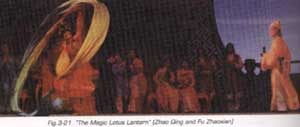 "The Magic Lotus Lantern" was a pioneer in the development of Chinese dance drama, with its influence spreading to both domestic and international dance stages. In 1959 "The Magic Lotus Lantern" was made into an art film and was highly acclaimed. It was nominated to the Dance Classics of the Chinese Nation in the 20th Century. (Fig.3-21)
"The Magic Lotus Lantern" was a pioneer in the development of Chinese dance drama, with its influence spreading to both domestic and international dance stages. In 1959 "The Magic Lotus Lantern" was made into an art film and was highly acclaimed. It was nominated to the Dance Classics of the Chinese Nation in the 20th Century. (Fig.3-21)
"Fish Beauty", which was first performed in 1959, is a collective creation by the second choreography class of the Beijing Dance School, under the instruction of Soviet expert Gusev, who's also the chief director Main staff members included Li Chengxiang(1931- ), Wang Shiqi (1932- ) and Li Chenglian(1931 -1993). (Composers: Wu Zuqiang and Du Mingxin; premiere staff: Beijing Dance School; leading female(s): Chen Ailian(A) and Chen Zemei(B) as the Fish Beauty; leading male(s): Wang Gengyao(A), Sun Zhengting(B) as the Hunter; main supporting role: Chen Mingqi as the Mountain Demon.)
"Fish Beauty" is a simple story. The beautiful Fish Beauty fell in love with the industrious and brave Hunter. The Mountain Demon was jealous of their love and sank the Hunter down to the seabed with his magic power and snatched the Fish Beauty. The Hunter saw through the Demon's attempts and resisted all kinds of temptations while the Fish Beauty remained faithful to their love. Finally the couple, assisted by the old Man of Ginseng, defeated the Mountain Demon and lived together forever.
Students at the choreography class during that period were all talented personnel in the field of dance who had been selected from across China. Gusev attached importance to bringing their individual talent into full play and the dance drama was created in several different, successive phases. A galaxy of talent made it a magnificent work and of great appeal to the audience. Dance steps and designs, Such as the pas de deux of the Fish Beauty and Hunter and the Fish Beauty and Mountain Demon, as well as "corals", "sea grass", and the "snake dance", which was designed to seduce the Hunter, were all excellent and exquisite. The notable improvements in the choreography of "Fish Beauty" demonstrated that Chinese directors of dance drama were maturing. The work was the Successful practice of "making foreign things serve China".
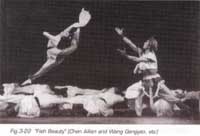 The premiere version of "Fish Beauty" has been included in the Dance Classics of the Chinese Nation in the 20th Century. (Fig.3-22)
The premiere version of "Fish Beauty" has been included in the Dance Classics of the Chinese Nation in the 20th Century. (Fig.3-22)
Also first performed in 1959, "Small Sword Society" is greatly different in style from the "Fish Beauty". (Choreographers included Zhang Tuo [1924- ], Bai Shui [1929-1993], Li Zhonglin, Shu Qiao [1932- ], and Li Qun [1934- ]; composer: Shang Yi; premiere: Shanghai Opera and Dance Drama Theater; leading female: Shu Qiao acts Zhou Xiuying; leading male: Chen jianmin as Liu Lichuan, Ye Yingzhang as Pan Qixiang; main Supporting role: Li Zhonglin as Wu jianzhang, a Qing Dynasty official.)
The "Small Sword Society" is the first grand dance drama presented by the Shanghai Opera and Dance Drama Theater after its establishment in 1956. Since then, Shanghai has always been the main stage for the development of Chinese dance drama.
After "The Magic Lotus Lantern", many dance dramas were adapted from fairy tales. The "Small Sword Society" made a breakthrough in expanding the Subject variety of Chinese dance dramas. The armed peasant uprising of the mid-19th century in China serves as the background for the dance drama. Leaders of "Small Sword Society" including Liu Lichuan, Zhou Xiuying and Pan Qixiang led an uprising in Shanghai against the feudal Qing officials and the imperialist invaders. They began the struggle by secretly organizing and arming the people and finally captured the Shanghai county. Wu Jianzhang, a Qing official, waged Suppression against the uprising. Pan Qixiang and Liu Lichuan died in the battle, while Zhou Xiuying, a heroine, continued to lead the struggle with great courage.
"Small Sword Society" vividly portrayed several characters with distinct features of the mid-19th century. The audience was very impressed with the Zhou Xiuying's heroic spirit, Liu Lichuan's resourcefulness and Pan Qixiang's iron will. Compared with "The Magic Lotus Lantern", "Small Sword Society" further enriched the dance by putting martial arts into the traditional opera dance, which greatly enhanced the characters' battling spirit as well as the skillfulness of the work. In addition, the folk dances of the Han nationality in southeast China gracefully blended Chinese national characteristics with distinct regional features.
In terms of the design of the dance, "Small Sword Society" was less influenced by ballet, so it had a clear-cut Chinese flavor and personality. The act of "Bow Dance", which depicts people's practicing martial arts, became a well-known independent dance piece with its vigorous and smooth body movements, as well as the lively stage design. The piece was awarded a gold medal at the 1961 World Youth Festival.
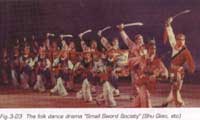 The "Small Sword Society" has left an indelible mark in the history of Chinese dance drama. It was included into the Dance Classics of the Chinese Nation in the 20th Century. (Fig.3-23)
The "Small Sword Society" has left an indelible mark in the history of Chinese dance drama. It was included into the Dance Classics of the Chinese Nation in the 20th Century. (Fig.3-23)
During this period, dance dramas based on the Subject of China's national minorities also emerged. Included are "Five Red Clouds", created and first performed in 1959 by the Soldiers Song and Dance Ensemble of the Guangzhou Military District, and "Manluo Flower" created and first performed in 1960 by the Guizhou Provincial Song and Dance Ensemble based on a folk story of the Miao people.
There were also a large number of works on the Subject of Chinese people's revolutionary struggle. The most well-known is "Die Lian Hua" (Butterflies Love Flowers) performed in 1959 by the Qianjin Song and Dance Ensemble of the Shengyang Military District. It was based on a poem written by the late Chairman Mao Zedong. There was also "Langya Mountain" performed in 1962 by the Song and Dance Ensemble of the General Political Department of the Chinese People's Liberation Army, commemorating five heroes during the Anti-Japanese War. These works all have distinctive features and styles, but in general they followed the principle of combining realism and romanticism to portray heroes of the times, which is an important Subject and tradition in the history of Chinese dance drama.
Chinese people love to watch their traditional operas with festive singing and dancing, and in the 1950s they nicknamed the new art form of the dance drama the "dumb show"' Yet the "dumb show" flourished in China in a relatively short period of time, a result of the support from the government, as well as people's diversified aesthetic demands. The development of Chinese dance drama consistently adhered to the principle of "making past things serve today and foreign things serve China". Research into China's national dance drama promoted the reform of traditional Chinese opera dance, hence a "classic dance style" gradually came into being.
The end of the "cultural revolution" brought a new life to China's art and Culture and the dance drama also had a golden opportunity to develop. There was a burst of enthusiasm for creation among China's professional dance contingent, including talented dance drama choreographers and directors. Grand Pieces of dance dramas were put onto the stage across China one after another. It's believed that through these grand works the artists could better express their feelings toward life after experiencing so many hardships. Furthermore, an opening society had expanded their horizon and enriched their creative experience.
First performed in 1979, "Tales of the Silk Road" caused a great stir across China. This epoch-making creative work has been recognized as one of the most brilliant dance dramas in the new historical period of China.
A collective creation, "Tales of the Silk Road" involved some of the best choreographers and directors of Chinese dance drama Such as Zhao Zhixun (1934- ) and Liu Shaoxiong (1933- ). Composers included Han Zhongcai and others. The premiere staff was the Gansu Provincial Song and Dance Ensemble (The later Gansu Opera and Dance Drama Theater and today's Dunhuang Art Theater). (Leading female: He Yanyun (A) and Fu Chunying (B) acted as Ying Niang; leading male: Zhong Minghua as "Magic Brush" Zhang, Li Weimin as Inuse, a Persian; main supporting roles: Zhang Ji as Dou Hu, the bandit; jia Shiming as Shi Cao.)
"Tales of the Silk Road" is a story that happened during one of China's most prosperous ages, the Tang Dynasty, with a strong flavor of the profound Dunhuang culture. It is an ode to friendship along the ancient Silk Road.
The prologue starts with a piece of melodious music, with Apsaras flying between colorful clouds. Amid the sound of camel rings, a team of Persian merchants pass along the Silk Road. A painter, "Magic Brush" Zhang, rescued Inuse, a Persian businessman who fainted but his beloved daughter Ying Niang was snatched by a bandit named Dou Hu.
In Act One, Ying Niang had grown up and become a street dancer. Inuse happened to see her and redeemed her back to her father. In Act Two, "Magic Brush" Zhang was painting his daughter in dance in the Mogao Caves. One of the paintings, "playing the Pipa (a plucked string instrument with a fretted fingerboard) by putting the instrument on her back", was extremely eye-catching. A local official Shi Cao, greedy for Ying Niang's beauty, wanted to take her as a concubine. "Magic Brush" Zhang had to entrust Ying Niang to lnuse's care.
Act Three expresses Ying Niang's strong longing for her father far away. in Act Four, "Magic Brush', Zhang missed his daughter so much that he dreamed of the colorful world painted by himself. In Act Five Inuse was named an envoy of the Persians to the Tang Dynasty and led Ying Niang back to her home, but official Shi Cao had an evil plan to help the Persian merchants."Magic Brush" Zhang learned about the plot and lighted the beacon-fire for help but was killed in the desert. In Act Six, Ying Niang, assisted by Inuse, sneaked into the Multi-national Trade Fair and disclosed the evil deeds of Shi Cao. A senior Tang official learned the truth and Shi Cao was beheaded. In the epilogue, the Silk Road resounds with the song of friendship.
"Tales of the Silk Road" had a positive theme: extolling friendship and an open society while castigating the evil forces, which best satisfied people's demand at a new historical period in China. The work had a novel Subject and style, with much emphasis on stage settings, choreography and the unique characteristic of the art of Dunhuang.
The staff of "Tales of the Silk Road" researched the dance murals in the Mogao Caves of Dunhuang with the assistance of experts and scholars. They selected certain dance designs from the 2,000-odd colored statues and more than 40,000-square-meter murals in the grotto. Further refinements and improvements were made to those static images which were revived on the stage and helped establish the dance drama's unique dance language. Following "Tales of the Silk Road", a Dunhuang-style Chinese dance began to thrive, which greatly enriched and expanded the classical dance of China.
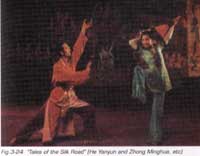 "Tales of the Silk Road" had been awarded the first place among the art works in a nationwide arts contest, which was held to celebrate the 30th anniversary of the founding of the People's Republic of China and was listed as one of the Dance Classics of the Chinese Nation in the 20th Century. (Fig.3-24)
"Tales of the Silk Road" had been awarded the first place among the art works in a nationwide arts contest, which was held to celebrate the 30th anniversary of the founding of the People's Republic of China and was listed as one of the Dance Classics of the Chinese Nation in the 20th Century. (Fig.3-24)
Echoing to the tremendous success of "Tales of the Silk Road", two other excellent dance dramas were put onto stage in Beijing Successively: "Princess Wencheng" and "Tongque ji" (Bronze Sparrow Dance). "Princess Wencheng" was first performed in 1981 and collectively created by Zhang Minxin (1935- ), Sun Tianlu (1934- ), Qu Yinsheng (1932- ) and others. The composer was Shi Fu, and the premiere Staff: China Opera and Dance Drama Theater (Leading female: Chen Ailian played Princess Wencheng; leading male: Han Daming as Songtsan Gambo; main Supporting male roles: Fang Bonian as Ge'er Dongzan, the Prime Minister, Liu Dekang as Emperor Taizong of the Tang Dynasty, Ji Jinwu as Chi Deng, a Tibetan general.)
The story, a historical fact, happened in the 17th century. Princess Wencheng of the Tang Dynasty was married to a Tibetan king. The dance drama depicts Princess Wencheng's love for her country by traveling from afar to Tibet to get married with the King of Tibet, Songtsan Gambo, a man of wisdom and courage. The marriage served as a bridge to promote the friendship between Tibet and inland China. In the drama, Prime Minister Ge'er DongZan was an official devoted to his post and general Chi Deng, however, schemed to damage the friendship and unity between the Han and Tibetan people.
Serving the need of the background story, "Princess Wencheng" employed the royal court dances of the Tang Dynasty, as well as Buddhist dancing and Tibet's folk dances, forming a distinctive feature of this artistic creation. The colorful folk dances and in particular the pas de deux of the princess and Tibetan king shows both softness and hardness of the couple in characters, and it impressed the audience with unbeatable harmony and elegance.
1985, "Tongque ji" is the representative work of sun ying(1930- ), an expert on the history of dance. (Composer: Zhang Dinghe and Zhang Yida; premiere staff: China Opera and Dance Drama Theater; leading female: Xia Lirong played Zheng Feipeng; leading male actor: Yu Jian as Wei Sinu; main supporting male role: Pan Jingsheng as Cao Pi.)
During the Three Kingdoms Period (200-280), a dancer named Zheng Feipeng was in love with Wei Sinu, a drummer The beautiful Zheng was taken away from Wei forcefully by the King of the Wei State, Cao Cao, and was subjected to endless bullying and humiliation by the Cao Cao and his son. Zheng resisted but was sentenced to death, and her lover Wei also lost his eyes. Wei beat drums to see off her lover to the execution ground. Zheng, filled with grief and indignation, left some of her hair to Wei and walked to face her destiny.
 Creator of "Tongque Ji" presented a tragic love story with a grand historical and Cultural background. Director Sun Ying studied and researched murals, stone paintings and dance images of the Han and Wei period for the creation. He also referred to materials related to the music, statues, paintings and calligraphy of the same period in an effort to expound his understanding of the Han-Wei style without limiting himself to the mere imitation of historical records. Though not as popular as "Dunhuang style", "Tongque Ji" established itself as a significant art work that plays a part in enriching Chinese national dance drama styles and promoting the innovation and reform of Chinese classical dances. (Fig.3-25)
Creator of "Tongque Ji" presented a tragic love story with a grand historical and Cultural background. Director Sun Ying studied and researched murals, stone paintings and dance images of the Han and Wei period for the creation. He also referred to materials related to the music, statues, paintings and calligraphy of the same period in an effort to expound his understanding of the Han-Wei style without limiting himself to the mere imitation of historical records. Though not as popular as "Dunhuang style", "Tongque Ji" established itself as a significant art work that plays a part in enriching Chinese national dance drama styles and promoting the innovation and reform of Chinese classical dances. (Fig.3-25)
Since the late 1970s, artists of Shanghai's dance drama circle Successively have presented a series of works. Included were "Ban Ping (Half Screen) Mountain" (1979), "Flying to the Moon" (1979), "Phoenix Singing at Qishan Mountain" (1981) and "The Legend of Hua Mulan" (1983). Each of the works had varying Subjects, styles, designs and themes, which was a reflection of the courageous pursuit for new art by Shanghai's artists.
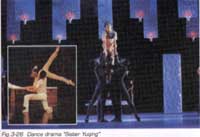 "Flying to the Moon" caused quite a stir among the audience. One of its creators, Shu Qiao, was invited to be the chief artistic supervisor of the Hong Kong Dance Troupe in 1983. During that period, she created a large number of dance dramas with different subjects and themes. In 1985, she cooperated with composer Ye Zhichun and choreographer and director Ying Eding to adapt the novel "Sister Yuqing" by Taiwan writer Bai Xianyong to a dance drama, which caught the attention of the writer himself as well as audiences from both home and abroad. (Fig.3-26)
"Flying to the Moon" caused quite a stir among the audience. One of its creators, Shu Qiao, was invited to be the chief artistic supervisor of the Hong Kong Dance Troupe in 1983. During that period, she created a large number of dance dramas with different subjects and themes. In 1985, she cooperated with composer Ye Zhichun and choreographer and director Ying Eding to adapt the novel "Sister Yuqing" by Taiwan writer Bai Xianyong to a dance drama, which caught the attention of the writer himself as well as audiences from both home and abroad. (Fig.3-26)
In 1979, the dance drama "Zhaoshutun and Nanmunuona" (names of the two leading roles of the Dai ethnic minority) was staged in Beijing, which achieved similar success to the "Tales of the Silk Road". Afterwards, a series of dance dramas created by China's national minorities met the audience successively and created an art gallery of ethnic dance dramas. The works included "Zhuowa Sangmu" (1980, Tibetan), "Pearl Lake" (1981, the Manchu nationality), "Deng Hua" (Lantern Flower), (1983, the Miao nationality), "Senji Dema" (1987, Mongolian), "Legend of Chunxiang" (1990, Korean) and "Ahshima" (1992, the Yi nationality. These dance dramas share a common feature that's characterized by profound cultural deposits, abundant artistic accumulations and a sense of creativity. Among these works, "Legend of Chunxiang" (created by Cui Yuzhu and won the Wenhua Grand Award in 1992) and "Ahshima" represented a breakthrough in terms of the Subject.
"Ahshima" was jointly created by Zhao Huihe, Zhou Peiwu (1936- ), Tao Chun and Su Tianxiang; composers: Wan Li and Huang Tian; first performed by the Yunnan Song and Dance Ensemble; leading female: Guo Lijuan (Naxi nationality, A), Yisu Lahan (Dai nationality, B) plays as Ahshima; leading male: Qian Dongfan (Hani nationality) as Ahhei, Tao Chun (Bulang nationality) as Ahzhi; main supporting male role: Zhang Laishan as Bi Mo.
"Ahshima" is a legend of the Sani people, a branch of the Yi national minority. The beautiful Sani girl, Ahshima, was in love with Ahhei, a brave shepherd. The son of the village head Ahzhi tried to force Ahshima to marry him, and the girl was even put into prison. Seeing a defiant Ahshima and her lover coming to her rescue, Ahzhi, furious and jealous, released floods by magic means and drowned the couple. At last Ahshima returned to nature by turning into a beautiful stone statue and remained in the Stone Forest foever.
"Ahshima" totally broke away from the traditional way of story-telling in the creation of dance dramas. Centering on the love conflict between Ahshima, Ahhei and Ahzhi, dance scenes of different colors: black, green, red, gray, golden, blue and white were designed to reveal the different characters of each role in a meticulous and exquisite way. The audience all marveled at the pas de deux and pas de trios of the three leads, as well as the colorful and brilliant traditional dances of the Yi nationality in different scenes. In "Ahshima", the creators, with their rich life experiences and profound artistic skills, endeavored to maintain the original flavor of the ethnic minority in the dance drama.
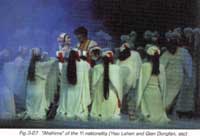 "Ahshima" won the Wenhuan Grand Award in 1994 and was listed as one of the Dance Classics of the Chinese Nation in the 20th Century. (Fig.3-27)
"Ahshima" won the Wenhuan Grand Award in 1994 and was listed as one of the Dance Classics of the Chinese Nation in the 20th Century. (Fig.3-27)
Also winning the 1994 Wenhua Grand Award was "Si Hai Xiao Yin" created by the Fujian Song and Dance Drama Theater (the creators included Yang Weihao). The dance drama depicts the thoughts and feelings of China's ocean shipping workers. With its well-knit dramatic settings and touching plots, it also achieved great success.
During this period, some modern dance dramas were also presented. Included were "Fan Yi", which was adapted from the well-known drama "Thunderstorm" by Cao YU; the "Grieving Trilogy" including "The Daytime Thinking", "The Plain" and "The Death Of Crying Phoenix", which were adapted from Ba jin's novel Family and Cao Yu's drama Sunrise and The Plain. There were also other works such as "The Snow Sister" and "Red Sorghum". These excellent art works had a variety of styles and didn't stick to only one pattern, and the creators even applied abstract means and expressionism in their works.
The emergence of these dance dramas was conducive to the enrichment of Chinese dance dramas. They also represented the openness of artistic creation in that period in China. "The Death Of the Singing Phoenix", as an independent work, was awarded the Gold award at the International Modern Dance Drama Contest held in Japan in 1985. Among the large number of dance dramas adapted from famous literary works, "The Remote Town" was the most successful. It was adapted and performed by the Hunan Song and Dance Ensemble from the novel of the same title by Shen Congwen. The author made it clear that he wanted to make an appropriate explanation for human love by writing the novel. The story happened in a small town in west Hunan province. Main characters included Cui Cui, who lived with her grandfather, and the brothers Tian Bao and Nuo Song, who both fell in love with Cui Cui. The love dispute between the two brothers and their fate, as well as the fate of other main characters, their thoughts and feelings, dominate the story. The dance drama, with the aim of exploring Cultural deposits, rural sentiment and the artistic character of the original work, condensed and elaborated on the "dance elements" in the novel. Centering on the main characters' thoughts and feelings, it fully revealed the novel's theme of pursuing a life of grace, health and naturatness. The solo dance, pas de deux and the group dance were all brilliant.
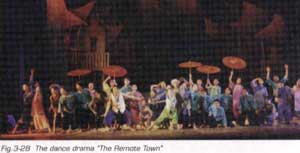 "The Remote Town" was choreographed by Xie Xiaoyong (1957- ), Wang Duanyi (1946- ) and Wang Xiaoyuan (1955- ). (Composer: Yang Tianjie; leading roles: Wang Xia as Cui Cui, Liu Yuebo as Nuo Song, Tao Xiaofa as Tian Bao, He Wei as grandfather.) "The Remote Town" won the 5th Wenhua Grand Award. (Fig.3-28)
"The Remote Town" was choreographed by Xie Xiaoyong (1957- ), Wang Duanyi (1946- ) and Wang Xiaoyuan (1955- ). (Composer: Yang Tianjie; leading roles: Wang Xia as Cui Cui, Liu Yuebo as Nuo Song, Tao Xiaofa as Tian Bao, He Wei as grandfather.) "The Remote Town" won the 5th Wenhua Grand Award. (Fig.3-28)
To Sum up, Chinese dance dramas with their national characteristics have maintained an innovative trend. Facing the increasing popularity of symphonic ballet and modern ballet, Chinese dance drama is continuing to develop while absorbing and drawing on the influence of foreign art.
